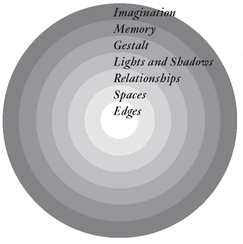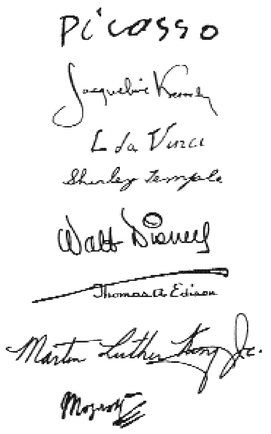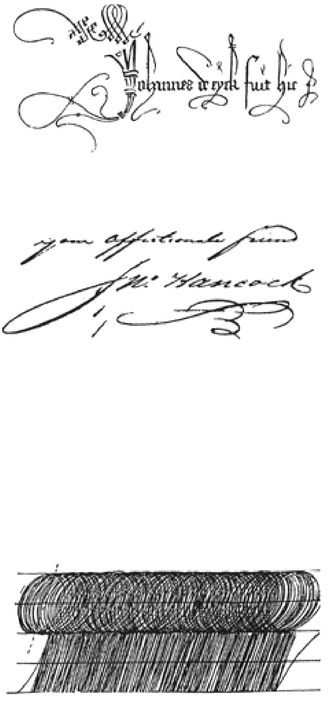The New Drawing on the Right Side of the Brain (52 page)
Read The New Drawing on the Right Side of the Brain Online
Authors: Betty Edwards

BOOK: The New Drawing on the Right Side of the Brain
4.41Mb size Format: txt, pdf, ePub
Ellsworth KelIy,
Apples
(1949). Pencil. Collection, The Museum of Modern Art, New York. Gift of John S. Newburry.
Apples
(1949). Pencil. Collection, The Museum of Modern Art, New York. Gift of John S. Newburry.
“In oneself lies the whole world and if you know how to look and learn, then the door is there and the key is in your hand. Nobody on earth can give you either the key or the door to open, except yourself.”
—J. Krishnamurti
You Are the World
You Are the World
“The life of Zen begins with the opening of
satori. Satori
may be defined as intuitive looking into, in contradiction to intellectual and logical understanding. Whatever the definition,
satori
means the unfolding of a new world hitherto unperceived.”
satori. Satori
may be defined as intuitive looking into, in contradiction to intellectual and logical understanding. Whatever the definition,
satori
means the unfolding of a new world hitherto unperceived.”
—D. T. Suzuki, “Satori,”
in
The Gospel According
to Zen
in
The Gospel According
to Zen
A
T THE BEGINNING OF THIS BOOK I said that drawing is a magical process. When your brain is weary of its verbal chatter, drawing is a way to quiet the chatter and to grasp a fleeting glimpse of transcendent reality. By the most direct means your visual perceptions stream through the human system—through retinas, optic pathways, brain hemispheres, motor pathways—to magically transform an ordinary sheet of paper into a direct image of your unique response, your vision of the perception. Through your vision, the viewer of the drawing—no matter what the subject—can find you, see you.
T THE BEGINNING OF THIS BOOK I said that drawing is a magical process. When your brain is weary of its verbal chatter, drawing is a way to quiet the chatter and to grasp a fleeting glimpse of transcendent reality. By the most direct means your visual perceptions stream through the human system—through retinas, optic pathways, brain hemispheres, motor pathways—to magically transform an ordinary sheet of paper into a direct image of your unique response, your vision of the perception. Through your vision, the viewer of the drawing—no matter what the subject—can find you, see you.
Furthermore, drawing can reveal much about you to yourself, some facets of you that might be obscured by your verbal self. Your drawings can show you how you see things and feel about things. First, you draw in R-mode, wordlessly connecting yourself to the drawing. Then shifting back to your verbal mode, you can interpret your feelings and perceptions by using the powerful skills of your left brain—words and logical thought. If the pattern is incomplete and not amenable to words and rational logic, a shift back to R-mode can bring intuition and analogic insight to bear on the process. Or the hemispheres might work cooperatively in countless possible combinations.
The exercises in this book, of course, encompass only the very beginning steps toward the goal of knowing your two minds and how to use their capabilities. From here on, having caught a glimpse of yourself in your drawings, you can continue the journey on your own.
Once you have started on this path, there is always the sense that in the next drawing you will more truly see, more truly grasp the nature of reality, express the inexpressible, find the secret beyond the secret. As the great Japanese artist Hokusai said, learning to draw never ends.
Having shifted to a new mode of seeing, you may find yourself looking into the essence of things, a way of knowing tending toward the Zen concept of satori, as described in the quotation of D. T. Suzuki. As your perceptions unfold, you take new approaches to problems, correct old misperceptions, peel away layers of stereotypes that mask reality and keep you from clear seeing.
With the power of both halves of the brain available to you and the myriad possible combinations of the separate powers of the hemispheres, the door is open to your becoming more intensely aware, more capable of controlling some of the verbal processes that can distort thinking—sometimes even to the extent of causing physical illness. Logical, systematic thinking is surely essential for survival in our culture, but if our culture is to survive, understanding how the human brain molds behavior is our urgent need.
Through introspection, you can embark on that study, becoming an observer and learning, to some degree at least, how your brain works. In observing your own brain at work, you will widen your powers of perception and take advantage of the capabilities of both its halves. Presented with a problem, you will have the possibility of seeing things two ways: abstractly, verbally, logically—but also holistically, wordlessly, intuitively.
Use your twofold ability. Draw everything and anything. No subject is too hard or too easy, nothing is unbeautiful. Everything is your subject—a few square inches of weeds, a broken glass, an entire landscape, a human being.
Continue to study. The great masters of the past and of the present are readily available at reasonable cost in books of drawings. Study the masters, not to copy their styles, but to read their minds. Let them teach you how to see in new ways, to see the beauty in reality, to invent new forms and open new vistas.
Observe your style developing. Guard it and nurture it. Provide yourself with time so that your style can develop and grow sure of itself. If a drawing goes badly, calm yourself and quiet your mind. End for a time the endless talking to yourself. Know that what you need to see is right there before you.
Put your pencil to paper every day. Don’t wait for a special moment, an inspiration. As you have learned in this book, you must set things up, position yourself, in order to evoke the flight to the other-than-ordinary state in which you can see clearly.
“Set yourself to practice drawing, drawing only a little each day, so that you may not come to lose your taste for it, or get tired of it. . . . Do not fail, as you go on, to draw something every day, for no matter how little it is, it will be well worth while, and will do you a world of good.”
—Cennino Cennini
Il Libro Dell’Arte,
c. 1435
Il Libro Dell’Arte,
c. 1435

Through practice, your mind will shift ever more easily. By neglect, the pathways can become blocked again.
Teach someone else to draw. The review of the lessons will be invaluable. The lessons you give will deepen your insight about the process of drawing and may open new possibilities for someone else.
Drawing skills six and sevenIn the Introduction, I mentioned that I have proposed two additional skills beyond the five basic component skills of seeing edges, spaces, relationships, lights and shadows, and the gestalt. My colleagues and I have not found more than these seven skills over the past decade, and it’s possible there are no more. Again, mediums, styles, and subject matter form an endless study, and all seven of the basic skills benefit by a lifetime of practice and refinement. But for basic understanding of the perceptual processes of drawing, the seven skills seem sufficient at this time. I’ll briefly review skills six and seven.
Perceptual skill six: Drawing from memorySkill six is essentially drawing from memory. Students yearn for this skill, but it is difficult. Drawing is a visual task and most artists have great problems drawing from memory except for those images they have drawn before. If someone asked me to draw a picture of an antique railway engine, for example, I could not do that because I don’t know what it looks like. If I could see a picture, or go to view the object, then I could draw it. Curiously, this occasionally comes as a surprise to people who don’t draw. They seem to think that an artist is someone who can draw anything.
Drawing from memory can be trained. The nineteenth-century French artist Edgar Degas, so the story goes, forced his students to study the model posing in the basement of a building and then climb to the seventh floor to do their paintings of the posed model. No doubt this was effective visual memory training!
For training yourself in visual memory, the key is to decide to remember—in a sense, to take a visual “snapshot” of an image you want to retain in memory. This means developing your ability to image—to see something with your mind’s eye well enough that later you can “look at” the image. Then, using the first five skills, you draw the image “seen in the mind’s eye.”
Additionally, whatever you draw will etch itself into your memory. Call up those images; see again the master drawings you have studied, the faces of friends you have drawn. Image also scenes that you have never viewed, and draw what you see through your mind’s eye. Drawing will give the image a life and reality of its own.
Perceptual skill seven: The “dialogue”Skill seven takes us all the way to the art of the museums, I believe. I briefly outlined some main aspects of this skill in Chapter Ten, page 221. The artist has a vague idea, let’s say, to draw a creature that never existed, perhaps a winged dragon. The artist has a vague imagined image and begins to draw, making a few marks that perhaps indicate the head of the dragon. Those marks trigger an imagined extension and elaboration of, say, the head and neck. The artist “sees” or envisions these elaborated details on the paper. The artist then draws in the imagined extension with new marks. That triggers an expanded image, perhaps the body and wings, now “seen” on the drawing. The artist is now able to draw those parts. And so the drawing progresses as a result of this “dialogue” between the imagined creature in the drawing which the artist makes real with the pencil marks. This dialogue continues until the artwork is finished.
You experienced this skill to some extent in your light/ shadow drawings, and you can now nurture this beginning. You will find it most satisfying, I assure you. One way to practice the dialogue is to find or make stained paper, stained perhaps with spilled coffee or smeared paint or even mud. Let the paper dry and then try to “see” images in the stains. Reinforce these images with pencil or pen or colored pencil. This is the so-called “da Vinci device.” Renaissance artist Leonardo da Vinci recommended that student artists should practice seeing fanciful images in the stained walls of the city in order to improve their imaging abilities.
“It is not to be despised, in my opinion, if, after gazing
fi
xedly at the spot on the wall, the coals in the grate, the clouds, the
fl
owing stream, one remembers some of their aspects; and if you look at them carefully you will discover some quite admirable inventions. Of these the genius of the painter may take full advantage, to compose battles of animals and of men, of landscapes or monsters, of devils and other fantastic things.”
fi
xedly at the spot on the wall, the coals in the grate, the clouds, the
fl
owing stream, one remembers some of their aspects; and if you look at them carefully you will discover some quite admirable inventions. Of these the genius of the painter may take full advantage, to compose battles of animals and of men, of landscapes or monsters, of devils and other fantastic things.”
Leonardo da Vinci (1452-1519)
Clearly, these skills have other applications. Use your imaging ability to solve problems. Look at a problem from several viewpoints and different perspectives. See the parts of the problem in their true proportion. Instruct your brain to work on the problem while you sleep or take a walk or do a drawing. Scan the problem to see all of its facets. Image dozens of solutions without censoring or revising. Play with the problems in the antic/serious intuitive mode. The solution is very likely to present itself nicely when you least expect it.
Drawing on the capabilities of the right side of your brain, develop your ability to see ever more deeply into the nature of things. As you look at people and objects in your world, imagine that you are drawing them, and then you will see differently. You will see with an awakened eye, with the eye of the artist within you.
Afterword: Is Beautiful Handwriting a Lost Art?
TO DAY, HANDWRITING IS NO LONGER a subject of interest. Like the times tables, moral sayings, and polite manners at tea parties, handwriting—if it is thought of at all—is relegated to quaint customs of the past century. Yet when I ask a group of people, “How many of you would like to improve your handwriting?” nearly all the hands go up. If I ask “Why?” the answers vary: “I want my handwriting to look better . . . to be more readable . . . to be good enough to be proud of.”
This response has surprised me. Handwriting has virtually been discarded as a school subject, at least beyond the third or fourth grade. Out of curiosity, I scoured my home library of books on the topics of education, school art programs, drawing, painting, art history, the brain and brain-hemisphere functions for index entries on handwriting. I found nothing, not a word on the subject.

Forgers copy signatures upside down. This trick probably works for the same reason that upside-down drawing works. As an exercise, try copying the signatures above upside down.

Other books
The Asylum by John Harwood
Color of Deception by Khara Campbell
Riders Of the Dawn (1980) by L'amour, Louis
Finding My Way Home by Alina Man
The One We Feed by Kristina Meister
Beneath the Bones by Tim Waggoner
Crusade of Tears: A Novel of the Children's Crusade by C. D. Baker
SnaredbySaber by Shelley Munro
Daughter of Asteria (The Daughter Trilogy) by C.M. Owens
Lionboy by Zizou Corder